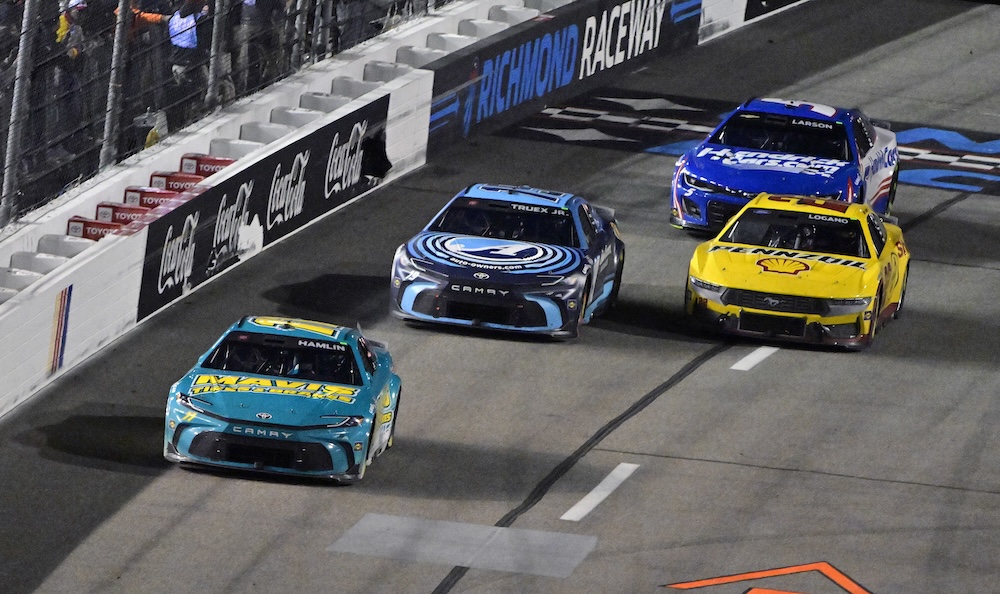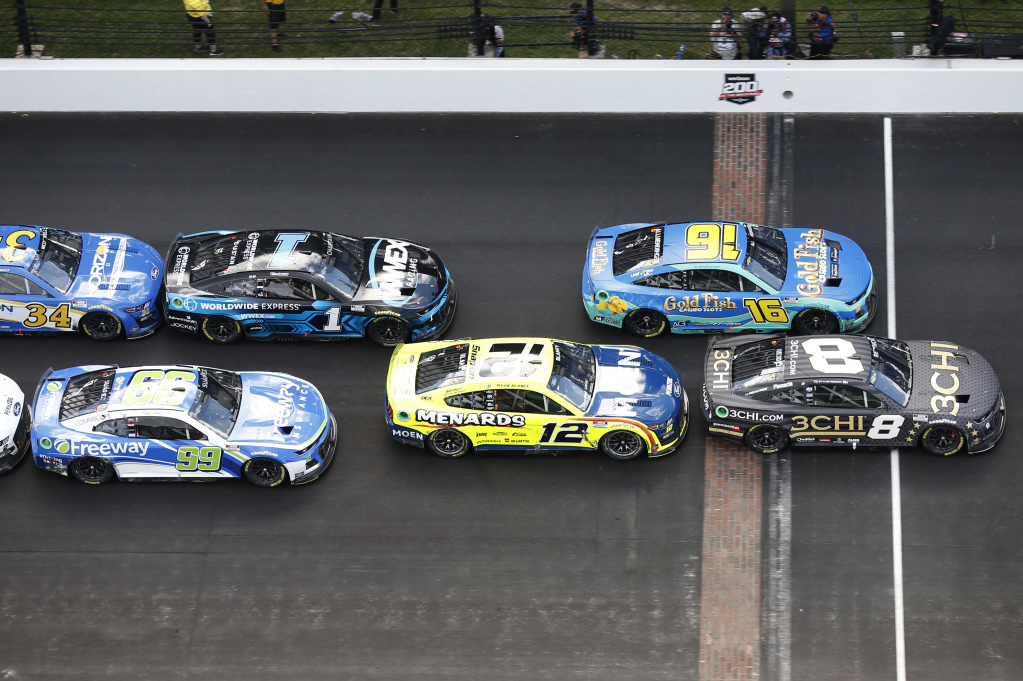A trio of NASCAR Cup Series drivers were unfazed Tuesday about the final restart at Richmond Raceway when leader Denny Hamlin fired off early.
“I didn’t see any issue with what happened,” Stewart-Haas Racing’s Josh Berry said. “I’ve raced a lot of short tracks and I’ve raced a lot of different rules — restart lines, restart zones, all these different things — and it’s really easy to completely handicap the leader. I think there’s got to be some flexibility there.”
Hamlin admitted he rolled early because he could see Martin Truex Jr. and Joey Logano lagging back to get a run. As the leader, Hamlin didn’t want to lose his advantage of being the control vehicle, and it was clear on video replay that he took off before hitting the line, which signifies the restart zone.
“I think the leader is the leader for a reason; he needs to have the right to control the restart and a lot like what Denny said, a lot of the times you’re judging what you’re going to do as the leader based off the car in second, third,” Berry noted. “These guys are laid back trying to time the run — they’re all trying to time it right, and sometimes you’ve got to push the envelope a little bit to basically not end up getting screwed out of the lead. Just in general, I think it’s really blown out of proportion.
“I don’t think it’s that big of a deal. I don’t think there needs to be data and policing. We need to have flexibility, and drivers need to be able to race and make decisions. If you wanted to make a call over a couple of feet of going early in the restart zone or before the restart zone, I think you just as easily make the same call if someone is laid back 3 feet versus 2 feet. I don’t think there’s a big issue with the restarts to me. It’s just blown out of proportion.”
[lawrence-auto-related count=3 category=1428]
Berry’s teammate, Ryan Preece, was just as passionate about the fact that there was no need for a ruling from NASCAR. Preece, who also has a short-track background, agreed the leader is sometimes at a disadvantage with a restart zone.
“You’re at the mercy of if I don’t go at the first line and you wait further into the box, well, what happens if the guy in second goes and has a nose out there and that’s not called?” Preece said. “Well, now you’ve lost the advantage. Or if you wait and then Joey [Logano] rolls up and has momentum on you and pulls out at the start/finish line, you get put three-wide going into Turn 1. It’s a lose-lose situation.
“So, at the end of the day that’s racing. I would have done the same thing (as Hamlin).”
Both agreed Hamlin did what he had to do. Sunday night, in the immediate aftermath, NASCAR senior vice president of competition Elton Sawyer said it was “awful close” but the restart was good. Tuesday morning, during his weekly appearance on SiriusXM NASCAR Radio, Sawyer admitted that Hamlin went early, and if it had been earlier in the race, it would have been dissected and reviewed differently.
“I think we all feel like they definitely are policed differently (depending on the lap),” Berry said. “The reality is that everyone wants transparency and they (NASCAR) were transparent, and now everybody doesn’t like that. We kind of know that if you just jump the opening start, you’re more likely to get a penalty than if it’s racing for the lead. Everyone is going to have a different opinion if that’s right or wrong, but I think that’s a thing. And as a driver, you feel like that’s a thing. So, I don’t know.”
Former Cup Series champion Brad Keselowski appreciated hearing from Sawyer. However, he wasn’t up in arms about what happened and pointed out how the conversation was about too much officiating a week before on the Circuit of The Americas road course.
“I really respected Elton Sawyer’s answer when he said they just missed it,” Keselowski said of the restart. “I think that’s OK. I think that happens in sports. In the ideal scenario, we don’t put them in a position where an official has to make a decision. We have all the technology and all the things to where everything is black and white. But the world is not that perfect, and the technology to do everything is hard to ascertain and make bulletproof.
“Sometimes things slip through the cracks. You get mad at them and then a week later, everybody seems to forget about them. But I think holistically, you’d like to solve for challenges like that just being careful that you don’t fall into the natural law of unintended consequences that seems to follow that. I saw Chad Little a few weeks ago and we were sharing a joke at COTA with respect to track limits of, this is what happens when you have definitive and perfect technology. You end up with 40-something penalties over a race weekend.
“So, I think COTA was a perfect example of how this can go the other way where you have the technology to solve challenges and you create black and white, remove some of the gray judgment calls, and people don’t like that either. I totally understand the challenge that those guys must face in picking a path for this (one). It’s the challenge of the week, and to be honest, if that’s the worst challenge we have coming out of Richmond, I think we probably had a pretty good week.”
Preece conceded it was a tough situation but doesn’t want to see judgment calls from NASCAR. In a way, Preece said restarts are predictable if the field knows when the leader will go because of the restart zone.
“We all know how to perform restarts and go do them,” Preece said. “We know when there’s games. Now, I don’t want to see leading that in the middle of (Turns) 3 and 4 decides to pick it up 10 miles an hour and then step on the brake. That’s something you do when you race go-karts or quarter midgets. When you get into a full-size race car when you know there’s a box, it’s consistent pace and then go. But I’m a fan of not having calls for a situation like that.”
In the end, the Stewart-Haas drivers humorously said it comes down to who was involved. If NASCAR were to have penalized Hamlin and taken the win away, there wouldn’t be the same uproar over officiating.
“No, because it was him,” Berry said. “If it was one of us, people wouldn’t even think about it, honestly. It’s subjective. If it’s myself or Ryan going for our first win, are you really going to call it because they went two feet early?”


